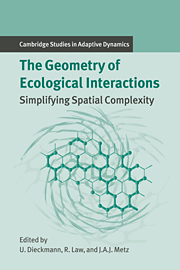Book contents
- Frontmatter
- Contents
- Contributing Authors
- 1 Introduction
- Part A Empirical and Statistical Background: A Plant Ecological Perspective
- Part B When the Mean-field Approximation Breaks Down
- Part C Simplifying Spatial Complexity: Examples
- Introduction to Part C
- 12 Spatial Scales and Low-dimensional Deterministic Dynamics
- 13 Lattice Models and Pair Approximation in Ecology
- 14 Moment Approximations of Individual-based Models
- 15 Evolutionary Dynamics in Spatial Host–Parasite Systems
- 16 Foci, Small and Large: A Specific Class of Biological Invasion
- 17 Wave Patterns in Spatial Games and the Evolution of Cooperation
- Part D Simplifying Spatial Complexity: Techniques
- References
- Index
- International Institute for Applied Systems Analysis
13 - Lattice Models and Pair Approximation in Ecology
Published online by Cambridge University Press: 14 January 2010
- Frontmatter
- Contents
- Contributing Authors
- 1 Introduction
- Part A Empirical and Statistical Background: A Plant Ecological Perspective
- Part B When the Mean-field Approximation Breaks Down
- Part C Simplifying Spatial Complexity: Examples
- Introduction to Part C
- 12 Spatial Scales and Low-dimensional Deterministic Dynamics
- 13 Lattice Models and Pair Approximation in Ecology
- 14 Moment Approximations of Individual-based Models
- 15 Evolutionary Dynamics in Spatial Host–Parasite Systems
- 16 Foci, Small and Large: A Specific Class of Biological Invasion
- 17 Wave Patterns in Spatial Games and the Evolution of Cooperation
- Part D Simplifying Spatial Complexity: Techniques
- References
- Index
- International Institute for Applied Systems Analysis
Summary
Introduction
Ecological interactions such as predation, resource competition, parasitism, epidemic transmission, and reproduction often occur at spatial scales much smaller than that of the whole population. For organisms with limited mobility, it is extremely important to explicitly consider the spatial pattern of individuals when predicting population dynamics.
Lattice or cellular automaton models are useful for modeling spatially structured population dynamics. These models are most suitable for population dynamics of terrestrial plants (Chapters 2 to 4, 6), including models for wave regeneration of subalpine forest (fir waves: Iwasa et al. 1991; Satō and Iwasa 1993), forest gap dynamics (Smith and Urban 1988; Green 1989; Nakashizuka 1991; Kawano and Iwasa 1993), and population dynamics of perennials capable of vegetative propagation (Crawley and May 1987; Silvertown 1992; Harada and Iwasa 1994; see also Chapters 3 and 4). Lattice models have also been developed for other systems, such as marine invertebrate communities (Caswell and Etter 1992; Etter and Caswell 1994), predator–prey dynamics (Tainaka 1988; de Roos et al. 1991; Wilson et al. 1993), host–pathogen dynamics (Ohtsuki and Keyes 1986; Satō et al. 1994), and host–parasitoid dynamics (Hassell et al. 1991a, 1994), as well as for spatially explicit evolutionary games (e.g., Herz 1994; Boerlijst and Hogeweg 1995a; Grim 1995; see also Chapter 8).
Most analyses of lattice models have used computer simulations of spatial stochastic processes. The results of these computer simulations can be compared with those of mean-field approximations, the traditional population dynamic models which neglect spatial structure and assume perfect mixing of populations.
- Type
- Chapter
- Information
- The Geometry of Ecological InteractionsSimplifying Spatial Complexity, pp. 227 - 251Publisher: Cambridge University PressPrint publication year: 2000
- 22
- Cited by



